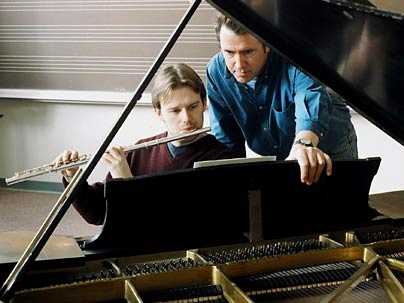"It's like an electrical current... if the river becomes wider, it can flow slower, but the same amount of water is flowing through." Ole Nielsen, a Ph.D. candidate in electrical engineering at MIT, was not lecturing a class of undergraduates on the principles of physics. He was explaining the feel of the final movement of "Four Autumn Sketches,"a new piece by composer and MIT staff member Graham Ramsay that Nielsen will premier at his flute recital on Friday, March 18, at 5 p.m. in Killian Hall.
Nielsen has played the flute since he was an 8-year-old back in Norway. Since entering the Experimental Study Group (ESG) as a freshman, he has performed in a recital every year as a requirement for the Emerson Scholarship, which covers the cost of his flute lessons.
Nielsen and Ramsay's collaboration has been two years in the making. Ramsay, who works for ESG as an administrator and teacher, attended one of Nielsen's annual recitals and was impressed. After the concert, he told Nielsen, "It would be interesting to write for you." They discovered they shared an admiration for French composer Henri Dutilleux and good scotch.
In writing "Four Autumn Sketch-es," Ramsay said he used the same approach he uses in his work as a commercial photographer, listening and getting input from his clients. As he finished each section, he handed it to Nielsen for feedback. As a clarinetist, Ramsay had some experience with woodwinds, but he relied on Nielsen to ensure that his piece truly worked for the flute. Too many composers write music that doesn't work for the instrument, said Ramsay, so it doesn't get performed. He wanted his piece to have a life after this first performance.
"Writing for a particular performer is much more gratifying," Ramsay said. The piece can be written with specific talents in mind. "Ole has splendid tone, and a wide range of colors available to him." In addition, he said, a performer's involvement in the writing process encourages him or her to invest more in the piece.
"Four Autumn Sketches" makes use of Nielsen's versatility. While the four movements were all inspired by Ramsay's impressions of New England in the fall, they are each, he said, quite different.
The first movement, "Courtyard, Boston Public Library," is the most lighthearted. Ramsay said its four sections, which are by turns quick, graceful, sprightly and broad, show different perspectives from inside the courtyard. The second movement, "Ghosts of Blanchard, Maine," is inspired by Ramsay's ancestral home in a now-extinct township, where the original stone walls remain, and it is "very, very grey" even in October, Ramsay said. Nielsen said that only the flute part is serially based, making the piece "less harmonically settling" and more "ghostlike."
By contrast, the sun is shiny in the third movement. Inspired by Concord's famous Walden Pond, it is tonal, harmonic and "stays pretty," Nielsen said.
Nielsen calls the fourth and final movement, "Rock River," a "wild" movement that invokes rapids: The music maintains a driving pace throughout, even while growing calmer in the middle.
The program will also include works by Bach and Robert Muczynski.
For more information, call 617-253-9800.
A version of this article appeared in MIT Tech Talk on March 16, 2005 (download PDF).






